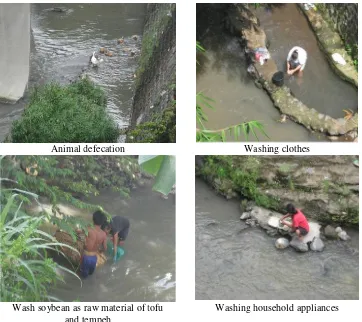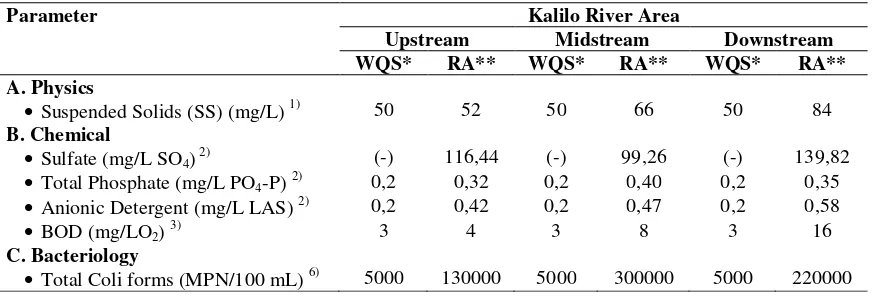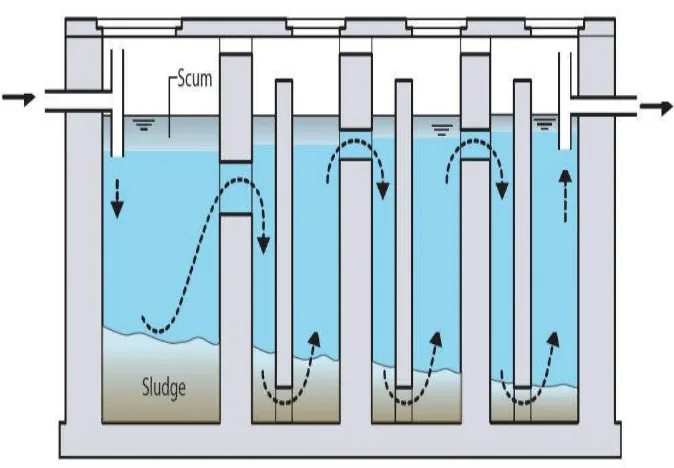ISSN: 2339-076X, Volume 1, Number 3 (April 2014): 143-148
DOI:10.15243/jdmlm.2014.013.143
Research Article
Kalilo river pollution due to limited land settlement and human
behavior along the Kalilo riverbanks
H. Suprihatin
Department of Environmental Engineering, Faculty of Civil Engineering and Planning, Institute of Technology Development Surabaya, Balongsari Praja V / 1 Surabaya, Tel (031) 7406783
e - mail : hasti.suprihatin @ yahoo.com
Abstract:
Kalilo River is one of the sights that is always visible to the people who come cross to Banyuwangi. However, there are many trash and animal (human) defecation in the Kalilo river that may impair the beautiful scenery of the river. This study was aimed to measure whether or not the physical, chemical and bacteriological parameters of the river water meets the criteria of Class II Water Quality Standard. River water samples were collected from upstream, midstream and downstream of the Kalilo river for suspended solid, sulfate, total phosphate, BOD, COD, DO, anionic detergent, total coliforms. Results of water analysis showed that the suspended solid, sulfate, total phosphate, BOD, COD, DO, anionic detergent, total coliform contents exceeded standard limit of the of Class II Water Quality Standard. Such conditions affect physical, environmental and economic development of the district. A Communal Waste Treatment Plant, Anaerobic Baffle Reactor (ABR), is recommended to overcome the problems.Keywords:land, human behavior, anaerobic baffle reactor.
Introduction
Kalilo river is located in Banyuwangi, East Java. Kalilo River is one of the sights that are always visible to the people who cross it. So aesthetic Kalilo river should be taken to be a beautiful scenery, comfortable and clean. The slope of the river Kalilo river is divided into 3 parts, namely: (1) Upstream: elevation is between ± 975.000 ms / d ± 2600.000 m above sea level with a length of 7.729 km and the river slope of 0.210, (2) Midstream: elevation is between 256.250 ms / d ± 975 000 m above sea level with a 11.482 km long river and slope of 0.063, and (3) Downstream: elevation is between ± 25,000 ms / d m above sea level with ± 256.250 11.041 km river length and slope of 0.022.
Until recently, there are many established settlements along the banks of the Kalilo river. This makes the river as a dumping place for trash and as well as a place for animal (and human) to defecate and do many other household activities (Figure 1). Banyuwangi regency has actually developed a Settlement Sanitation Development Acceleration Program (PPSP) to improve and
sanitary conditions in the residential areas, especially those along riverbanks. During the year of 2010-2014, the PPSP focuses on specific goals namely,
(1) closing open defecation, both in urban and rural areas through the provision of access to a centralized sewer system by 10 %, and local processing system by 90 % of the Indonesian population,
(2) reduction of waste through the 3R program and improvement of waste management such as the application of environmentally friendly sanitary landfill or controlled landfill to landfill and safe technology for 80 % of households in urban areas, and
(3) reduction in the puddles of 100 strategic urban areas prone to flooding that cover and the area of 22,500 ha.
chemical and bacteriological parameters of the river water meets the criteria of Class II Water Quality Standard.
Methods
This study was an observational study to measure the organic content in the river Kalilo and to determine the cause of pollution. The parameters observed in this study were physical, chemical and bacteriological characteristics of the river water whether they meet the criteria of Class II Water Quality Standards, the corresponding PP No. 82, 2001 of14, 2001. River water samples
were collected from upstream, midstream, and downstream of the Kalilo river and brought to the laboratory for suspended solid, sulfate, total phosphate, BOD, COD, DO, anionic detergent, total coliforms analyses.
The analyses were conducted following the Service Standard Guidelines for Determination of Minimum Service Standards Manual Field of Spatial Planning, Housing and Settlements and Public Works (decree No.. 534/Kpts/M/2001, Minister of Settlement and Regional Infrastructure of the Republic of Indonesia).
Animal defecation Washing clothes
Wash soybean as raw material of tofu and tempeh
Washing household appliances
Figure 1. Activities of communities along the Kalilo river
Results and Discussion
The Kalilo river water quality
Results of laboratory analysis showed that the suspended solids in the river water ranged from 52 mg/L (upstream) to 84 mg/L (downstream) (Table 1). These values have exceeded the quality standard of PP No.82 of 2001. This indicates that sustainability of aquatic life in the Kalilo river
will be seriously impaired due to lack of oxygen in the river water. The BOD values were 4 mg/L O2, 8 mg / L O2, and 16 mg / L O2 in upstream,
midstream and downstream areas, respectively. These values were much higher the Quality standard BOD (3 mg / L O2) (Table 1). The
upstream area (13000 MPN/100 mL) (Table 1). The values are much higher than the standard value of 5000 MPN/mL. The concentrations of
sulfate, phosphate and anionic detergent of the Kalilo river water exceeded the quality standard (Table 1).
Table 1. Physical, chemical, and biological characteristics of Kalilo river water
Parameter Kalilo River Area
Upstream Midstream Downstream
Anionic Detergent (mg/L LAS)2) 0,2 0,42 0,2 0,47 0,2 0,58
BOD (mg/LO2)3) 3 4 3 8 3 16
C. Bacteriology
Total Coli forms (MPN/100 mL)6) 5000 130000 5000 300000 5000 220000
*) Water Quality Standards Class II, the corresponding PP. No.. 82, 2001, December 14, 2001 **) Results of Analysis,1) Gravimetric method,2)Spectrophotometer method,3) Winkler method,4)Reflux/Titrimetric method,5) Iodometry method,6)Multi Tube Fermentation method.
Identified problems related to the Kalilo river water quality
Socio-Cultural Aspects
Defecating on Kalilo river, washing cookware cooking, washing clothes, and washing of soybeans to be used as raw material for the manufacture of processed foods and tofu. People dispose of their domestic waste into the river Kalilo, as well as for small and medium industries to easily dispose of their waste water into the river Kalilo.
Environmental aspects
Solid Waste Aspect
Garbage service coverage is still low.
Lack of socialization and education that most people treat or dispose of waste by burning waste is not in place.
3R waste management was still not approached.
Inadequate transportation and equipment
Inadequate number and capacity of waste management of human resources
Landfill does not have a standard (Sanitary Landfill)
Sanitation
Public sanitation conditions are still below standard
Sanitation activities which interfere with the aesthetics of the urban environment
The low public awareness of environmental sanitation
Problems of land for the placement of the program means
Community development issues
Domestic Wastewater
Public access to latrine coverage is still low.
The absence of regulations made by the Local Government relating to the management of liquid waste both household and industrial scale.
Most of the people using the latrine with septic tank construction are not eligible causing vulnerability to contamination.
Pemerintah Banyuwangi regency has not been able to implement a centralized sludge treatment system.
Possible negative impacts of the Kalilo river water quality
Sedimentation potential
sustainability of aquatic life in the Kalilo river will be seriously impaired due to lack of oxygen in the river water. The lack of oxygen was because of the decay of contaminants that enter to the river. Disposal of domestic sewage in the river can increase the levels of BOD in the water. The high content of BOD in a river can lead to siltation due sedimentation in the river. This is due to reduced oxygen levels in the water entered so that biota will experience death. Reduced oxygen levels due to the presence of contaminants that enter these waters so blocking oxygen into the river (Metcalf. and Eddy, 1991). Contaminants or pollutants that enter the river are pollutants that can not be unraveled, this is due to the amount of pollutants entering the river so that the bacterial decomposition is no longer able to outlining these pollutants. Laboratory results of water samples from the river downstream Kalilo show that the BOD values were 4 mg /L O2, 8 mg / L O2, and
16 mg / L O2 in upstream, midstream and
downstream areas, respectively. These values were much higher the Quality standard BOD (3 mg / L O2) (Table 1). From the economic point of
view, this is very harmful, due to the silting of the Kalilo river, small riverboats are unable to enter the Kalilo river. Yet, riverboat is one of Banyuwangi tourism sectors that contributes to the income of the local government of Banyuwangi.
Environmental Health
The highest number of total Coliforms in the Kalilo river water was observed in the midstream area (30000 MPN/100mL) and the lowest was in the upstream area (13000 MPN/100 mL) (Table 1). Te values are much higher than the standard value of 5000 MPN/mL. Those high numbers of total Coliforms seemed to be due to many communities who still use the Kalilo riverbanks for defecation that increased the amount of bacteria in the river water. The high total Coliform can cause diseases such as diarrhea, gastroenteritis, typhoid.Yet, the river water is also used by communities to support their actitivitis, asuch washing cookware, clothes, soybean as raw material of tofu and tempeh (Figure 1). In addition to the biological parameter, the concentrations of nitrite, total phosphate and anionic detergent of the Kalilo river water exceeded the quality standard (Table 1).
This indicates that the river has been polluted by domestic and industrial activities of the households along the riverbanks. There are many people who have a semi-permanent home, such as the districts Tukang Kayu and Kepatihan.
Productivity of society
Tofu and tempeh are common daily foods consumed by Banyuwangi people. Most of the tofu and tempeh small industries along the riverbank of Kalilo use the river water to wash the raw material material of tofu and tempeh (soybean). The reduced quality of the Kalilo river will affect the quality and tofu and tempeh consumed, and eventually will affect the community health. The decreasing the level of public health will reduce the productivity of the communities along the Kalilo river. Declining productivity societies will limit the economic conditions of the people because they may not be able to work properly.
Recommended solutions
Accelerating and increasing targets of Settlement Sanitation Development Acceleration Program in accordance with Service Standard Guidelines for Determination of Minimum Field of Spatial Planning, Housing and Settlements and Public Works (Minister of Settlement and Regional Infrastructure No. 534/KPTS/M/2001)
Increasing numbers of healthy latrine with septic tank, accompanied by local regulations to enforce law for all people in Banyuwangi.
Providing sanctions to people who build houses in the Kalilo riverbanks and providing alternative locations for people living in densely populated areas.
Figure 2. Schematic diagram of ABR (Anaerobic Baffled Reactor)
Table 2. Advantages and Disadvantages of Anaerobic Baffle Reactor
Advantages Disadvantages
Resistant to hydraulic shock loads and organic substances
Requires constant source of water
Does not require electricity Require secondary treatment effluent or discharged into a suitable place
Can be repaired and built with locally available materials
The decrease in the low pathogenic substances
Long service life Preliminary processing required to prevent clogging
Decreased high organic matter
Low investment and operating costs
Not need large area Requires constant source of water
Require secondary treatment effluent or discharged into a suitable place
The Decrease in the low pathogenic substances
Preliminary processing required to Prevent clogging
Conclusion
Kalilo river is polluted, it is confirmed from the results of laboratory Kalilo river water samples taken at the downstream, midstream and upstream. Parameters that exceed the quality standards for Class II waters are Sulfate, Total Phosphate, Nitrite, BOD, Anionic Detergent and Total Coliforms. Sources of pollution caused by waste household activities and household
Reference
Anonymous. 2001. PP. No.. 82, 2001 Date of December 14, 2001: On Air quality Management and Water Pollution Control.
Barber, W.P, and Stuckey, D.C. 1999. The Use of the Anaerobic Baffled Reactor (ABR) For Wastewater Treatment: A Review. Wat. Res. Vol. 33. No.. 7. Elsevier Science Ltd.. London.
Metcalf, J. and Eddy. G. 1991. Waste Water Engineering Treatment, Disposal and Reuse. 3 th Edition, Revised by George Tchobanoglous and Franklin. L.Burton. Mc Graw Hill, New York.
Nachaiyasit, S. and Stuckey, D.C.1997. The Effect of Shock Loads on the Performance of an Anerobic Baffled Reactor (ABR) 1. Step Changes in Feed Concentration at Constant Retention Time. Wat. Res. Vol. 31. No.. 11. Elsevier Science Lyd. London.


